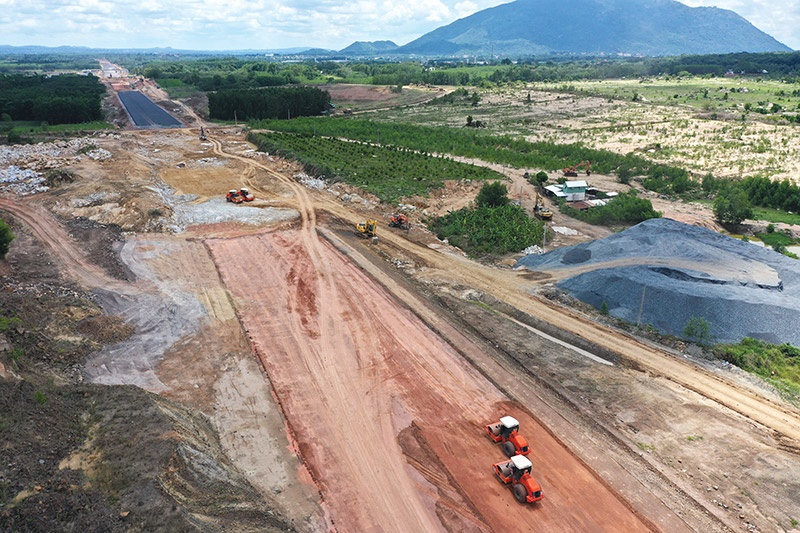Solutions sought to aid road schemes
 |
| The North-South Expressway is perhaps the most vital piece of infrastructure to propel the nation forward. Photo: Le Toan |
Contractors of a bidding package for Mai Son Highway No.45, which is part of the eastern portion of the North-South Expressway, are the latest to have sent letters to the Ministry of Transport (MoT) to consider and remove difficulties hit by the price hikes of fuel and raw materials.
State-run Corporation 319, managed by the Ministry of Defence, and privately-owned Cuong Thinh Thi Construction Investment Group JSC have asked for help to push ahead with the construction of roads that are crucial for the country’s development.
Mai Son Highway No.45, which is being funded fully by public investment, was expected to be put into operation at the end of this year and had previously reported the best performance among 11 sub-projects of the North-South Expressway’s eastern cluster before the pandemic emerged. However, over recent months, its progress has stalled due to the sharp rise in input material costs, which have tripled since contracts were signed in 2020.
Doan Kien Trung, deputy director general of Cuong Thinh Thi, said that petrol, diesel, steel, cement, and even asphalt, a key material in the construction of expressways, have soared in price due to the pandemic and the Ukraine conflict. “Huge costs for purchasing materials along with the scarcity of materials and workers are exhausting contractors. In particular, construction of this road is costing $4.3 million but the company is suffering $2.2 million in losses,” said Trung.
Receiving complaints from contractors, the MoT has reported to the government and collaborated with the Ministry of Construction (MoC) to discuss solutions that are yet to emerge.
“Over recent months, contractors on public investment projects and the North-South Expressway, in particular, cannot maintain the progress and high work intensity,” said an MoC representative. “Construction sites do not have enough raw materials, fuel, and construction equipment. People cannot work, causing huge losses to contractors, wasting resources, reducing the efficiency of publically-funded projects, and slowing down national growth.”
The Ministry of Planning and Investment’s report on socioeconomic development and public investment disbursement in the first half of the year showed that the disbursement rate of public investment was 27.75 per cent of the plan assigned, a slight decrease on-year. Of this, disbursement of domestic capital was 29.06 per cent, a slight decline on-year (31.75 per cent), while that of foreign capital was 9 per cent of the allocated plan.
Seven ministries and 12 localities reported performance of higher than 35 per cent, while 40 of 51 ministries and agencies, and 25 of 63 localities reported disbursement at less than 25 per cent. Of these, 25 ministries and one locality reported disbursement at less than 10 per cent.
In addition to establishing six task forces to help accelerate public investment disbursement, the prime minister has spent numerous weekends visiting cities and provinces, assessing the challenges, boosting project performance, and building strategies.
According to reports from ministries, agencies, and localities, the hike in material prices is the biggest issue, followed by the struggle to recruit new workers.
What the stars mean:
★ Poor ★ ★ Promising ★★★ Good ★★★★ Very good ★★★★★ Exceptional
 Tag:
Tag:
Related Contents
Latest News
More News
- Ho Chi Minh City backs $2 billion AI data centre with dedicated task force (January 06, 2026 | 08:43)
- PM sets January deadline for high-speed rail consultant (January 06, 2026 | 08:40)
- New decree spurs on PPP implementation (December 31, 2025 | 19:01)
- Global alliance develops $1 billion AI data centre network in Vietnam (December 30, 2025 | 10:08)
- Standing out in the Chinese outbound investment wave (December 29, 2025 | 10:29)
- Bright spots obvious in foreign investment mission (December 29, 2025 | 09:00)
- Ho Chi Minh City hits $8.37 billion in FDI (December 29, 2025 | 08:28)
- Vietnam and UK cooperation backs finance talent for IFCs (December 27, 2025 | 16:31)
- Global partnerships key to Vietnam’s IFC development (December 26, 2025 | 16:18)
- Vingroup pulls out of bid to invest in North-South high-speed railway (December 26, 2025 | 11:42)























 Mobile Version
Mobile Version